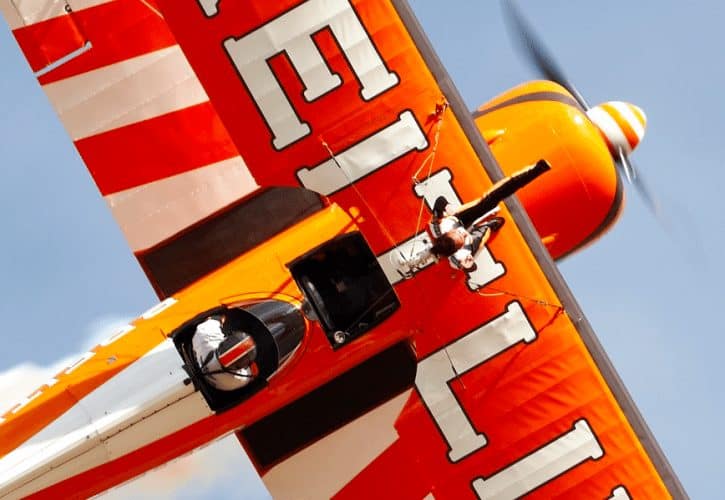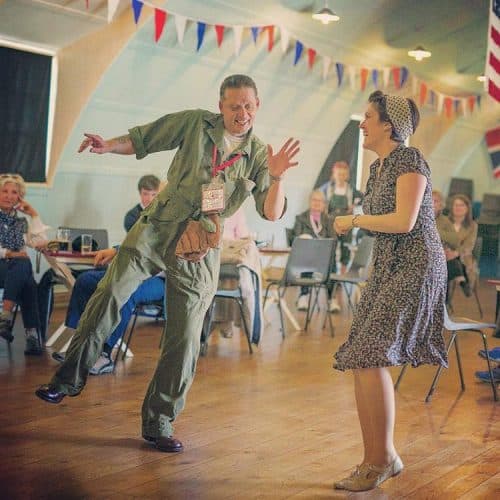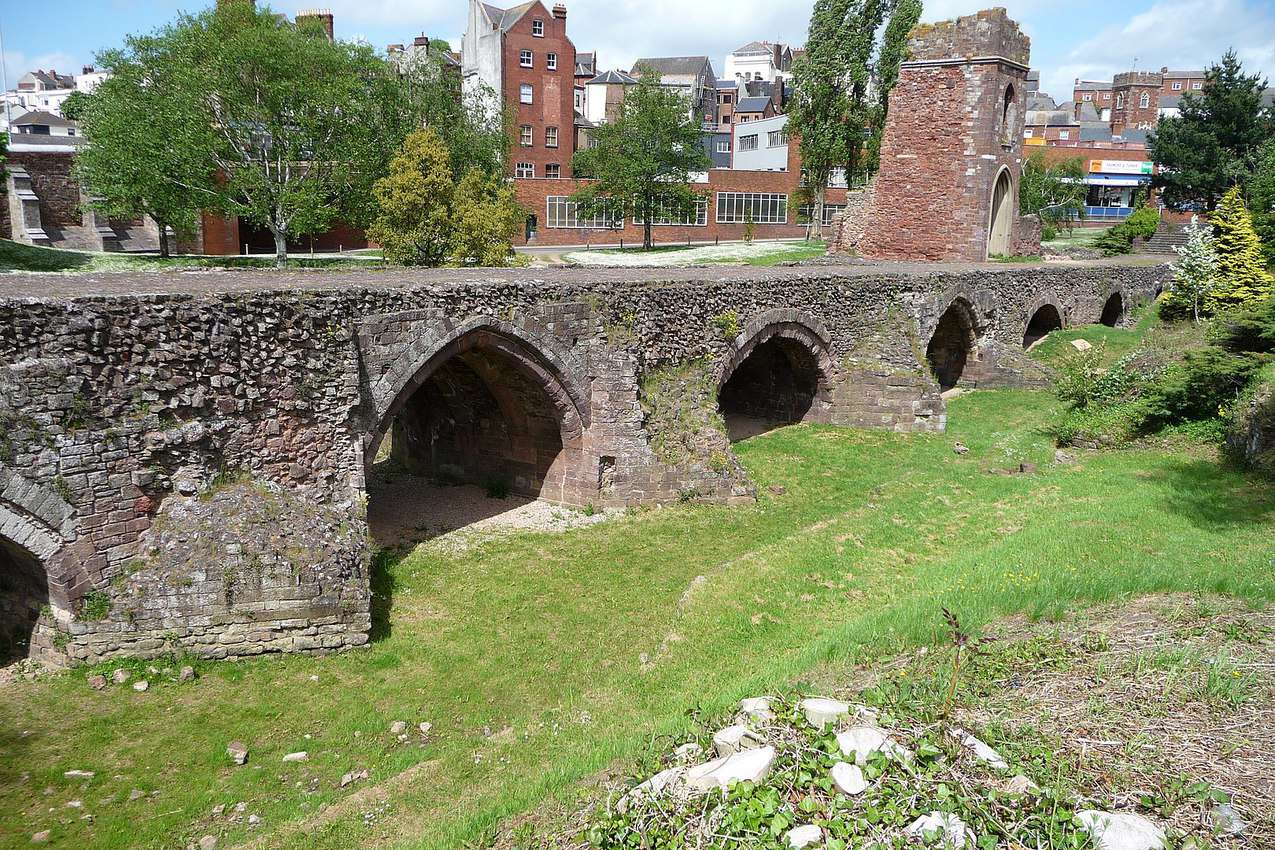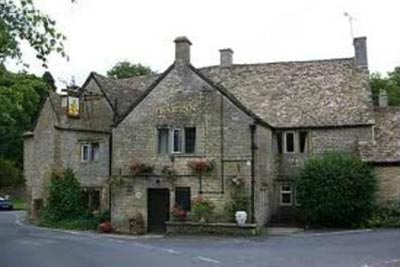
The Friendly Invasion of East Anglia
By Christine O’Toole
As a brassy “In the Mood” wafted from the bandstand, a group of airmen in khaki rush the dance floor, twirling their high-heeled dates below red, white, and blue bunting.

The scene had all the clichés of a Hollywood wartime movie: the big band, the Forties playlist, and the energetic couples.
But at this “hangar dance” in East Anglia, a group of Brits played the part of the Yanks.
The discovery felt weirdly disconcerting. It was like arriving at Valley Forge and being surrounded by redcoats impersonating Colonials.
But the reenactment wasn’t just cosplaying. It’s part of a heartfelt salute to the U.S. Eighth Air Force, which flew thousands of bombing missions from here into Nazi Germany during World War II.
D-Day Tourism
While D-Day tourism is a hot ticket in France and Belgium, rural England’s dances, air shows, and monuments are grassroots tributes to the era they call “the friendly invasion.”
“It’s kind of an obsession,” explained Ross Armitage. He and his wife Anne, both in their late twenties, are members of Liberation 44, a local living history group that organizes dances and meet-ups. They clued me in to the must-see sites—from Tudor-era pubs to tiny rural airbases to vast aviation museums—for American history buffs to visit.

We began in Cambridge. An easy hour-long train ride from London’s King’s Cross, the ancient university town is a natural place to begin a jaunt through East Anglia (formally, Cambridgeshire, Norfolk, and Suffolk).
After Evensong at King’s College Chapel, we walked to the Eagle, a pub that’s served thirsty young men since 1667.
Among those patrons were thousands of American GIs, who left their mark. The parchment-colored ceiling of the RAF Bar is a Dali-esque scrawl of female nudes, insignia, and signatures, mementos of the American flyers stationed here from 1942 to 1945.
Beneath the graffiti, barmen pour some of the region’s best beers.
Bury St Edmunds
I savor a pint of Greene King, an IPA brewed in nearby Bury St. Edmund’s. Pete Waters, a local, tells me that Greene’s kept the Eighth Air Force afloat: Air Force Commander and Hollywood star Jimmy Stewart ordered that the brewery is kept open for the duration of the Eighth’s bivouac.
The next morning we crept out of the crowded city center to Duxford, a 13-mile drive on the M-1 motorway. A hulking khaki-green cargo plane alongside the road was our signpost for the Imperial War Museum.
Duxford is the aircraft campus for the London-based IWM. Its vast airfield hosts vintage air shows. Its newly revamped American Air Museum does a good job of connecting the massive planes on display—like the World War II-era Flying Fortresses and Liberators—with amazing personal stories.
Exhibits highlight survivors of the bombing campaign, like Duke Boswell, who jumped out of a C-47 transport aircraft on D-Day, and Huie Lamb, a fighter pilot who was forced to ditch his P-51 Mustang in the North Sea.

At the museum, I meet Andy Garner and his son Toby, re-enactors clad in vintage khaki jumpsuits. A softball mitt dangles from Andy’s belt; Toby sports a ball cap with “SNAFU” stitched on the brim.
Both are active volunteers at 95th Bombing Group Museum at Horham, home of the first U.S. bomb group to bomb Berlin in daylight.
The museum is also home to the Red Feather Club. Each month, Andy, DJ’ing under the name Andy AV-8, hosts swing dances in the spirit of Glenn Miller, who played here in on his last tour in 1944. “We get 200 people out,” he says cheerfully. “It’s brilliant.”
A Half-Million Americans, Thousands of Deaths
The perfectly flat farms and fenlands east of Cambridge were ideal launch points for bombing raids into occupied Europe. Over seventy small bases like Horham were home to nearly a half-million airmen and ground crew, who suffered staggering losses. Those forced to bail out over occupied territory faced capture and torture as POWs.
Only one in four U.S. airmen survived their missions. Author Harrison Salisbury grimly described service in the Eighth as “a ticket to your own funeral—and you’re waiting in line for it.”

The sacrifice is honored on a grand scale at the Cambridge American Cemetery. I hadn’t known that this is the only U.S. military cemetery in the British Isles.
More than 3,800 U.S. servicemen are interred here, and another 5,100 MIAs are remembered, in a setting reminiscent of Arlington or the Ardennes.
Fields of white headstones curve toward the medieval towers of Ely Cathedral. We were invited to linger for the flag-lowering ceremony, conducted at 4:30 each afternoon, and explore a new indoor visitor’s center that puts the European campaign in the context of the worldwide air war.
A time Warp
The evening was a time-warp through the 15th and 20th centuries at Lavenham’s Swan Hotel. The Suffolk village was one of the wealthiest wool towns of the Tudor-era, and the wood-timbered hotel, with vast open fireplaces, has been a meeting spot ever since. Here again, the Yanks left their marks.
The walls of the Airmen’s Bar, like the Eagle in Cambridge, are covered with the signatures of World War II airmen from the 487th Bombardment Group, based nearby. The hotel’s vintage weekends take place each May when U.S. Army Jeeps line the High Street.
On our final morning, we travel slowly north on the A140 to Thorpe Abbott. Our destination is a cinderblock control tower overlooking a short airfield and a line of Quonset huts. This was the home of “The Bloody Hundredth,” now the 100 th Bomb Group Memorial Museum. While the bravery of the unit is legendary, so is the spirit of its current-day volunteers.
Unsolicited Keepsakes

Deborah Harvey greets us. Following in her father’s footsteps, the Dickleborough native has collected the artifacts and stories of the flyers who served here. The control tower includes audio interviews from many of them; their sheepskin flying suits, letters, and other mementos are displayed throughout. Harvey says the keepsakes often arrive unsolicited, donated by U.S. families.
The 100th Museum is particularly proud of the engines and equipment on display in the engine shed. On a shoestring budget, its volunteers continue to preserve its history. In February, producers from a forthcoming HBO series visited Dickleborough in person, scouting authentic locations for the film.
Kirk Saduski was among them. After producing HBO’s “Band of Brothers” and “The Pacific,” Saduski is now working on the series, tentatively titled “Masters of the Air.” For him, the story of the Yanks who became part of the British homefront is compelling. “This, more than anywhere else we served, was home,” he said.
For more information on The Friendly Invasion, including itineraries and guided tours.
Visit East of England and Visit Britain

Chris O’Toole is a feature and travel writer based in Pittsburgh, Pa. Her work appears in books, magazines, and newspapers across the U.S. In 2017, she has reported from New Orleans, Winnipeg, East Anglia, and West Virginia. She has been an Anglophile since first hearing The Beatles and still hopes to meet Paul McCartney.
Eurail Passes: What to Know about Buying a Europe Train Pass
- Saudi Arabia Might Be Your Next Getaway Spot - April 23, 2024
- Mongolia, the Land of Eternal Blue Sky - April 20, 2024
- These 9 U.S. National Parks Require Reservations in 2024 - April 17, 2024





